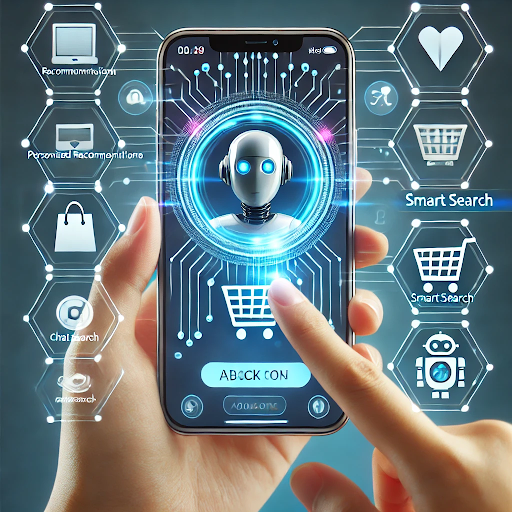AI is revolutionising the eCommerce sector by improving the user experience, automating procedures, and increasing sales. Grand View Research predicts the AI in the eCommerce market would reach $11.1 billion by 2032 (source). AI-powered eCommerce apps provide personalized suggestions, chatbots, fraud detection, and automated inventory management, making online buying more convenient and efficient.
If you want to create a revolutionary eCommerce platform, partnering with an eCommerce app development company can help you efficiently integrate AI-driven features.
Step 1: Define Your Goals and Features
Before starting development, outline the core objectives of your AI-powered eCommerce app. Some key AI-driven features include:
- Personalized Product Recommendations – AI analyzes user behavior to suggest relevant products.
- AI Chatbots for Customer Support – 24/7 instant responses to customer inquiries.
- Voice Search & Virtual Assistants – Enable users to search using voice commands.
- Automated Inventory Management – AI predicts demand and manages stock efficiently.
- Fraud Detection & Security – AI detects suspicious transactions and prevents fraud.
Step 2: Choose the Right Technology Stack
Your app’s success depends on the right combination of technologies. Some key technologies for AI-powered eCommerce apps include:
- Programming Languages: Python, JavaScript, Swift, Kotlin
- AI & ML Frameworks: TensorFlow, PyTorch, Scikit-learn
- Databases: Firebase, PostgreSQL, MongoDB
- Cloud Services: AWS, Google Cloud, Microsoft Azure
Step 3: Develop AI Algorithms and Models
AI-driven Ecommerce apps rely on machine learning algorithms to enhance functionality. Key AI models used include:
- Collaborative Filtering – Recommends products based on user behavior.
- Natural Language Processing (NLP) – Enhances chatbot communication and search functions.
- Computer Vision – Enables visual search and image-based recommendations.
- Predictive Analytics – Forecasts trends and customer preferences.
If you need advanced AI implementation, collaborating with a machine learning development company can help integrate powerful ML models tailored to your app’s needs.
Step 4: Design a User-Friendly Interface
An AI-powered eCommerce app must have an intuitive and visually appealing design. Key UI/UX principles include:
- Easy Navigation – Simple and clear categories.
- Personalized User Experience – AI adapts recommendations based on user interactions.
- Quick Checkout Process – Reduce cart abandonment with easy payment options.
Step 5: Integrate AI-Powered Chatbots and Customer Support
AI chatbots improve customer service by providing instant assistance. They handle common queries, suggest products, and assist in tracking orders. Some popular AI chatbot solutions include:
- IBM Watson Assistant
- Google Dialog Flow
- Microsoft Bot Framework
Step 6: Implement Smart Search and Recommendation Engines
AI-powered search improves product discoverability by understanding user intent. Some methods include:
- Semantic Search – AI understands context instead of just matching keywords.
- Voice and Visual Search – Users can search with voice commands or images.
- Behavioral Analysis – AI tracks browsing habits to suggest the right products.
Step 7: Secure Payments and Fraud Detection
AI strengthens eCommerce security by detecting fraud and securing transactions. AI-based fraud prevention systems analyze:
- Unusual purchase patterns
- Multiple failed login attempts
- High-value transactions from new locations
Step 8: Test and Optimize the App
Thorough testing ensures your AI-powered eCommerce app performs well. Key testing methods include:
- Performance Testing – Ensures the app runs smoothly under heavy traffic.
- Security Testing – Identifies vulnerabilities in payment gateways.
- User Testing – Gathers feedback to improve user experience.
Conclusion
Building an AI-powered eCommerce app requires a combination of the right technology, AI integration, and seamless user experience. AI enhances personalization, automates processes, and ensures security, making online shopping better for customers and businesses alike.
For businesses looking to implement advanced AI solutions, working with an Artificial Intelligence development company can help integrate cutting-edge AI technologies that transform the eCommerce experience.







